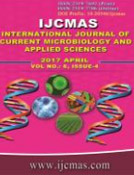


 National Academy of Agricultural Sciences (NAAS)
National Academy of Agricultural Sciences (NAAS)

|
PRINT ISSN : 2319-7692
Online ISSN : 2319-7706 Issues : 12 per year Publisher : Excellent Publishers Email : editorijcmas@gmail.com / submit@ijcmas.com Editor-in-chief: Dr.M.Prakash Index Copernicus ICV 2018: 95.39 NAAS RATING 2020: 5.38 |
Soil forms an integral part of the ecosystem and at present the quality of a soil is defined not only in terms of its productive capacity, but also by taking the ecosystem into consideration. Consequently, when soil productivity has to be maximized, environmental effects must be given proper consideration. Thus the changes in soil quality caused by different types of land use must first be quantified for attaining sustainability in use and management. In order to understand the soil function on a firm scientific basis one cannot neglect the biological and biochemical processes taking place in the soil. Microbiological parameters form an important component of the soil ecosystem perturbations. Information on soil microorganisms and their activity used to determine microbiological characteristics are very important for soil quality and productivity. Studies of enzyme activities also provide information on the biochemical processes occurring in soil. Moreover the soil biological parameters are considered to be the potential and sensitive indicators of soil ecological conditions and management. Therefore mapping of these properties helps to determine the level of spatial variability of these properties in soil. Geostatistical methods can be satisfactorily used to evaluate the soil microbiological parameters statistically. Geostatistics consists of modeling the spatial variation to create the semivariogram and kriging to produce maps. Semivariograms describe the semivariance between sampling locations at a different lag distance. Kriging is a linear interpolation procedure that provides estimates at unsampled sites.
 |
 |
 |
 |
 |